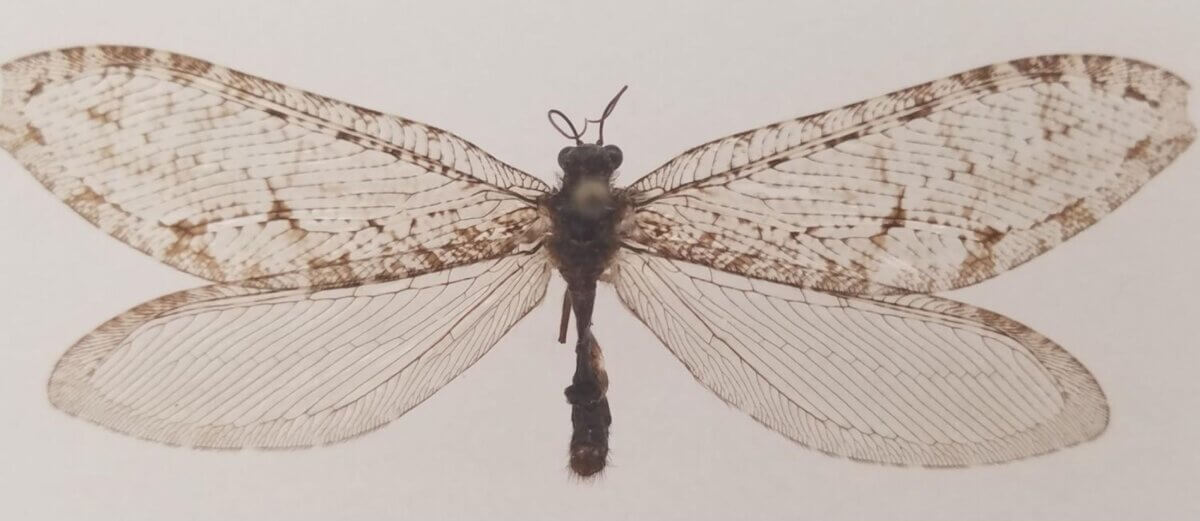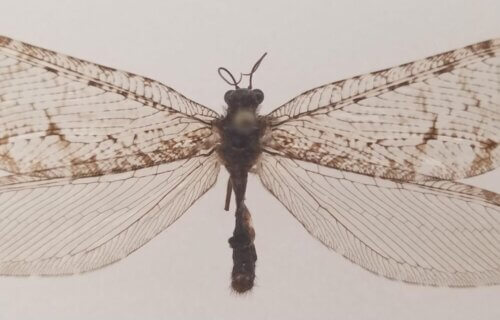UNIVERSITY PARK, Pa. — Walmart seems to be stocked with pretty much everything, including a rare insect that dates back to prehistoric times! Called the giant lacewing, researchers say the bug was discovered at a Walmart in Arkansas. It’s the first recorded sighting in eastern North America in over 50 years and the first giant lacewing discovered in the state.
“I remember it vividly, because I was walking into Walmart to get milk and I saw this huge insect on the side of the building,” says Michael Skvarla, the director of Penn State’s Insect Identification Lab, who was a doctoral student at the University of Arkansas at the time of the discovery, in a media release. “I thought it looked interesting, so I put it in my hand and did the rest of my shopping with it between my fingers. I got home, mounted it, and promptly forgot about it for almost a decade.”
While Skvarla actually found this insect in 2012, he misidentified it and only recently uncovered its true identity when the COVID pandemic hit — eight years later. Skvarla was teaching an online insect biology course at Penn State, when he showed students microscopic samples of his personal insect collection. While lecturing on a specimen he previously labeled as an “antlion,” he quickly realized that its features did not match those of the dragonfly-like predatory insect. The wingspan of the insect was 50 millimeters, way too large for the average antlion.
“We were watching what Dr. Skvarla saw under his microscope and he’s talking about the features and then just kinda stops,” describes Codey Mathis, a doctoral candidate in entomology at Penn State who was in Skvarla’s Zoom class. “We all realized together that the insect was not what it was labeled and was in fact a super-rare giant lacewing. I still remember the feeling. It was so gratifying to know that the excitement doesn’t dim, the wonder isn’t lost. Here we were making a true discovery in the middle of an online lab course.”

The giant lacewing lived with the dinosaurs!
The giant lacewing used to be a normal sight across North America over the past century. In the 1950s, however, the species seemed to disappear from eastern United States. Finding a giant lacewing after all this time suggests there may be relic populations of the large, Jurassic-Era insect. Skvarla and his colleagues performed a DNA analysis of the specimen to absolutely confirm its identity as a giant lacewing. The insect is now in the Frost Entomological Museum at Penn State, where people can access it for future research purposes.
“It was one of those experiences you don’t expect to have in a prerequisite lab course,” says Louis Nastasi, a doctoral candidate studying entomology at Penn State. “Here we were, just looking at specimens to identify them and all of a sudden, out of nowhere, this incredible new record pops up.”
Skvarla found this giant lacewing in the urban area of Fayetteville, Arkansas. While it remains a mystery as to why giant lacewings disappeared, finding one in Arkansas could give some clues.
“Entomology can function as a leading indicator for ecology,” Skvarla explains. “The fact that this insect was spotted in a region that it hasn’t been seen in over half a century tells us something more broadly about the environment.”
Some scientists have theorized that insects disappeared because of the increasing use of artificial light, urban air pollution, and the suppression of forest fires in eastern North America. What’s more, predators such as large ground beetles and non-native earthworms may have changed the composition of forest leaf litter and soil — making the region uninhabitable for lacewings.
There could be more species hiding in the Ozarks
Fayetteville is located within the Ozark Mountains, which are thought to be a biodiversity hotspot. Many endemic species, including 68 kinds of insects and at least 58 species of animals and plants, live in the Ozarks. Compared to other regions like the Southern Appalachians, researchers say they know much less about the Ozarks.
“This combination makes the region an ideal place for a large, showy insect to hide undetected,” says Skvarla and his coauthor J. Ray Fisher of the Mississippi Entomological Museum at Mississippi State University.
There is still the question of how the giant lacewing made its way to a Walmart. Since it was found on the side of a well-lit building at night, it’s possible the bug was attracted to the lights and flew a few hundred meters from where it lived.
“It could have been 100 years since it was even in this area—and it’s been years since it’s been spotted anywhere near it. The next closest place that they’ve been found was 1,200 miles away, so very unlikely it would have traveled that far,” theorizes Skvarla.
The Walmart-loving specimen may be a member of a rare, surviving eastern population of giant lacewings that evaded extinction.
“Discovery doesn’t always hold that same kind of grasp on people that maybe it did 100 years ago,” says Nastasi. “But a finding like this really highlights that even in a run-of-the-mill situation, there are still a tremendous number of discoveries to make about insects.”
The study is published in the Proceedings of the Entomological Society of Washington.

